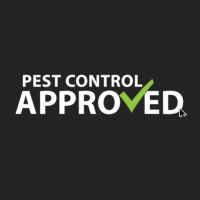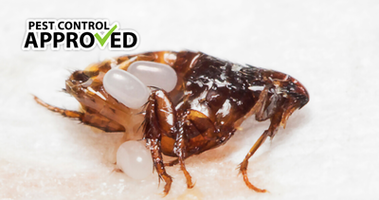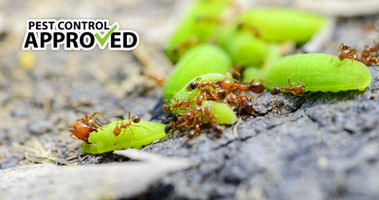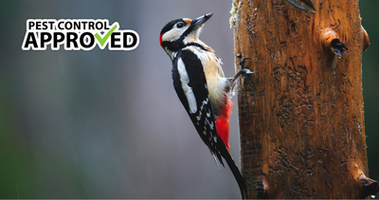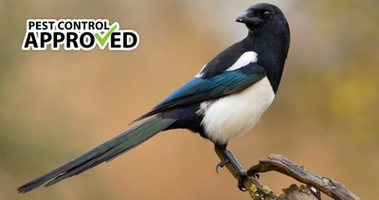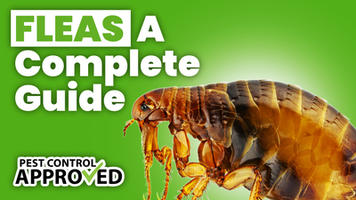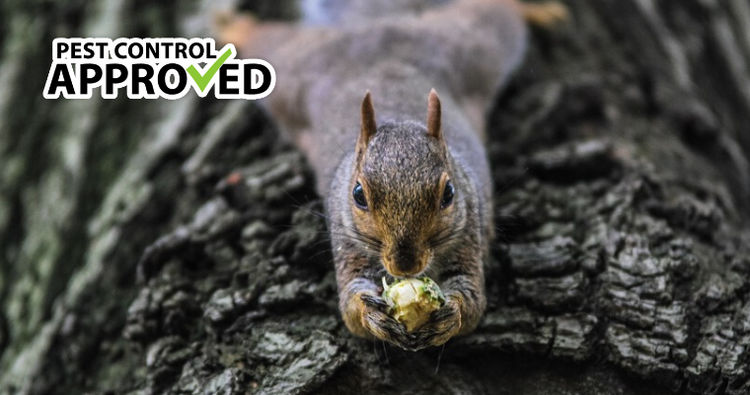
Identifying the Droppings
Squirrel droppings are similar to other rodent droppings. They are dark brown, black, or red and lighten as they age. Squirrel droppings are fatter and more numerous than rat droppings, but still no larger than a jellybean. They are about 3.1 milometers (1/8th inch) in diameter and 9.6 milometers (3/8th inch) long. In outdoor environments, squirrel poop is often found in clusters under trees or around a bird feeder. Indoors, squirrel poop will be found in the attic, or higher points of the home. Unlike other rodents, they will rarely leave droppings on the floor or in corners.
The Dangers of Squirrel Droppings
Squirrel droppings, like all rodent droppings, can carry a variety of diseases and parasites that are harmful to humans and pets. Squirrels frequently have salmonella bacteria in their droppings. They are also frequent carriers for fleas and ticks that can carry Lyme disease or Rocky Mountain Spotted Fever. Squirrel droppings can also increase the severity of asthma or allergies and worsen many breathing problems. Most diseases and parasites are harmless until the droppings or squirrel den is disturbed. More rarely, squirrels may carry rabies, the plague, or typhus.
Salmonella
Salmonella is a bacteria that frequently lives in the intestines of animals. In large concentrations, it can be harmful. Salmonella infections occur from consuming food or water contaminated by feces, or by touching infected animals or their droppings. In restaurants, salmonella is often caused by improper hand washing or food handling. There are multiple types of salmonella including salmonellosis, typhoid fever, and paratyphoid fever. Rodents generally carry salmonellosis. Salmonella begins six hours to two days after eating contaminated food or drink or touching infected droppings. Common symptoms include nausea, vomiting, stomach cramps, and diarrhea. Less frequently, headaches, chills, and bloody stool can occur. While most individuals recover in a few days with fluids and rest, high risk individuals, such as the immunocompromised, those with bowel disorders, and children, may experience serious symptoms such as dehydration, reactive arthritis, and brain infections. Antibiotics and I.V. fluids can be used to treat salmonella when necessary.
Fleas and Ticks
Fleas and ticks are small parasites that commonly feed on human and animal blood. Ticks can be as small as a pin head or as large as a pencil eraser. They are reddish-brown and prefer to burrow in human armpits, groins, or hair. After biting, they will often stay lodged in the skin. Fleas are small, flat parasites. They are 1- 4 milometers long. While they do not stay attached to skin, they often reside in their host’s fur or hair. Both fleas and ticks can be spread by an infected squirrel. Their bites can carry dangerous diseases such as Lyme, Rocky Mountain Spotted Fever, or even the plague. Although squirrels are not their main host, they can easily spread fleas and ticks (and their diseases) to humans or pets.
Rocky Mountain Spotted Fever
Rocky Mountain Fever (RMSP) is a bacterial disease spread by ticks to their hosts. Symptoms generally occur within a week but can occur up to 14 days after infection. RMSP’s most common symptom is a red, non-itchy rash that spreads up and down arms and legs, starting at the wrists and ankles. The rash can look like large spots, small dots, or red splotches. General symptoms include fever, headache, nausea, stomach pain, muscle pain, appetite loss, and confusion. RMSF can progress rapidly and can cause brain, heart, or lung inflammation, kidney failure, and potential limb amputation. A firm diagnosis cannot be made by the appearance of a rash; a fecal test is necessary. RMSF is treatable with the antibiotic doxycycline.
Lyme Disease
Lyme disease is another serious and often chronic condition arising from an infected tick bite. While more common in the United States of America, in recent years, Lyme disease has become more common in Canada. The first symptoms of Lyme disease are fever, chills, headache, fatigue, muscle aches, joint pain, and swollen lumps under armpits (lymph nodes). Some Lyme infections present with a target-shaped rash, but frequently the rashes are completely red and about 5 centimeters (2 inches) in diameter. The rash is warm to the touch, but not painful or itchy. Later symptoms of Lyme disease are more serious and include neck stiffness, severe headache, severe joint pain, facial drooping, muscle weakness, irregular heartbeat, shooting pains, and brain inflammation. Testing for lime disease is based on symptoms and a two-stage blood test. Lyme disease is treated with antibiotics. Without treatment, it can cause arthritis and nerve damage.
The Plague
Although extremely rare in modern society, small outbreaks of the plague still occur. In 2013 and in 2015, California trapped infected squirrels in local parks. Yersinia pestis (Y-pestis) is the bacteria that causes the plague in humans. Y-pestis bacteria is passed on when an individual is bitten by an infected flea or touches an infected animal. The bacteria enter the body through broken skin. Symptoms begin within six days of contact. General symptoms include feeling weak, fever, headache, fatigue, and muscle aches. These symptoms come on quickly. Advanced symptoms depend on type of plague. There are three forms of the plague: bubonic plague (a.k.a. Black Death), septicemic plague, (blood infection) and pneumonic plague (lung infection).
- Bubonic Plague: Swollen lymph nodes in the arms, neck, and groin about size of chicken egg. They are tender to the touch and may release blood or pus.
- Septicemic Plague: Bleeding under the skin or from the mouth, nose, or rectum. Also includes belly pain, vomiting, and shock.
- Pneumonic plague: Rarest, but most contagious form. Symptoms include bloody cough, breathing trouble, nausea, vomiting, high fever, and chest pain
Complications of the plague include gangrene, meningitis, and, frequently, death. Fortunately, a strong course of antibiotics is effective.
Typhus
Typhus is a bacterial disease caused by the Rickettsia Typhi or Rickettsia Prowazekii bacteria. Individuals become sick one to two weeks after they are bitten by an infected flea, mite, or chigger. In squirrels, fleas are the most common carriers. The primary symptoms include fever, chills, headache, rapid breathing, muscle aches, rash, nausea, cough, and confusion. After about a week, a rash appears on the back or chest. The rash then spreads outward and further symptoms manifest such as delirium, coma, or light sensitivity. A blood test is used to diagnose Typhus. Without treatment, up to 60% of patients die. Luckily, Doxycycline, an antibiotic, is an effective treatment, especially when given early in the disease.
Rabies
Rabies is a deadly virus that infects the spinal cord and brain. Although often associated with bats, rabies can be transmitted by any infected mammal. It is spread through the saliva or brain tissue of an infected animal. A person must ingest infected brain tissue or be scratched or bitten by a rabid animal. While rare, it is 100% fatal without prompt treatment. The first symptoms are similar to the flu: fever, headache, and nausea. Later symptoms include anxiety, confusion, difficulty swallowing, partial paralysis, and hallucinations. Once the early symptoms appear, it is too late for treatment. Therefore, it is important to go to the doctor if you think you have been bitten or scratched by a squirrel. If possible, bring the animal with you. Doctors can test the animal for rabies through a necropsy (post-death examination). A series of post-exposure vaccines can treat rabies if they are given before symptoms appear.
Protection During Squirrel Waste Removal
One must take precautions before cleaning up a squirrel infested area. Proper attire is the best way to avoid contracting a serious disease. Because the risk of infection is high, a professional exterminator is usually recommended. If you are cleaning or removing a squirrel infestation or nest, do so with extreme caution and wear proper equipment. It is best to clean up after dark when squirrels are asleep of have been removed. If there is activity in the attic, we highly recommend hiring a professional roofing contractor like Kymand Roofing to help repair the entry point.
- Wear rubber or latex gloves, a protective mask (N95 mask), and shoe coverings. Wear disposable coveralls or old clothing that can be washed immediately after cleaning.
- Disposable coveralls are preferred. If possible, acquire a respirator and a negatively pressured air purifier. It is important to avoid stirring up infected particles.
- Spray feces and nest materials with a bleach water solution. The solution should be one part bleach, ten parts water. Spray the affected areas with the solution and let it sit for five to ten minutes.
- Remove feces and nest materials with a paper towel or vacuum. A vacuum is ideal because it will further prevent the spread of airborne infections.
- Empty the vacuum bag or canister into the garbage nag and dispose of the garbage immediately. Wipe down the outside of vacuum with the bleach solution. If using paper towel, place it in the garbage bag and immediately remove the bag from the house.
- Disinfect all floors, walls, counter tops, and hard surfaces with a bleach solution. Steam clean or shampoo carpets and cloth furniture.
- Wash affected bedding and clothes with hot water and detergent.
- Finally, remove and dispose of protective equipment and wash your hands immediately. You may wish to shower to remove any potential contamination. If possible, open windows and doors to air the room out.
Dead squirrels should be treated with the same precautions as their droppings and nests. Wear protective equipment and place the squirrels in a sealed plastic bag. Place the plastic bag in a second sealed bag before disposing of in the garbage bag. Always wash your hands after handling their remains.
In Conclusion
Squirrel droppings are brown ovals about the size of a jellybean. They are commonly found in attics or under trees and bird feeders. Their droppings can carry ticks, fleas, and various serious diseases. Cleaning should be done wearing protective equipment such as gloves and masks to prevent infection. A thorough cleaning of all surfaces in the room should be done with bleach.

